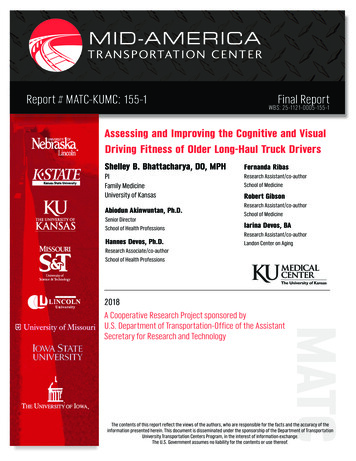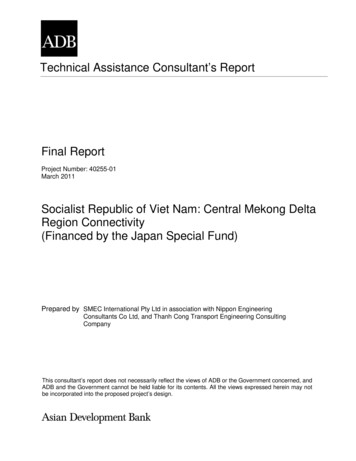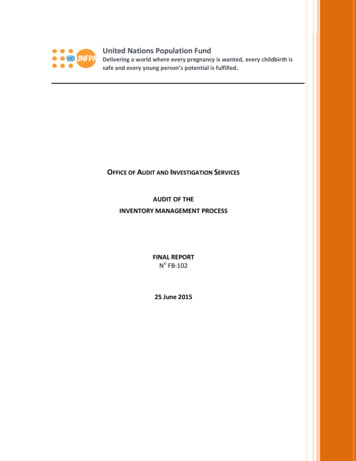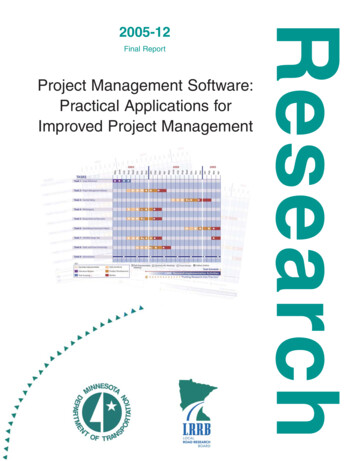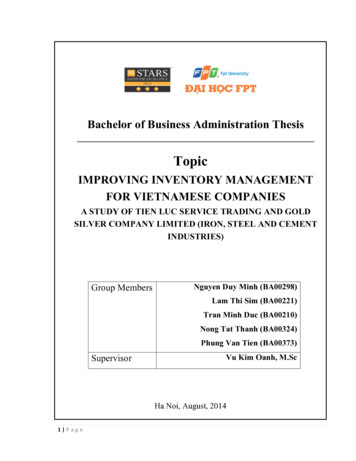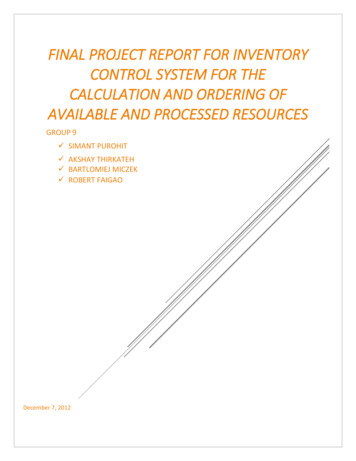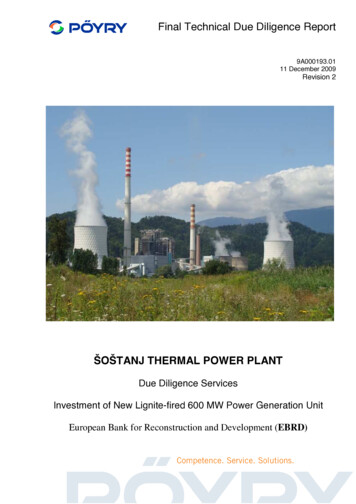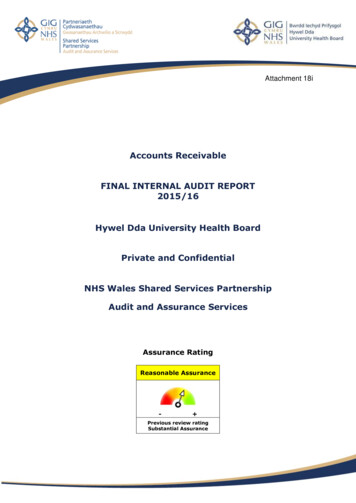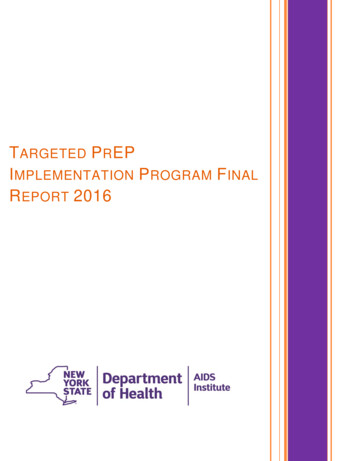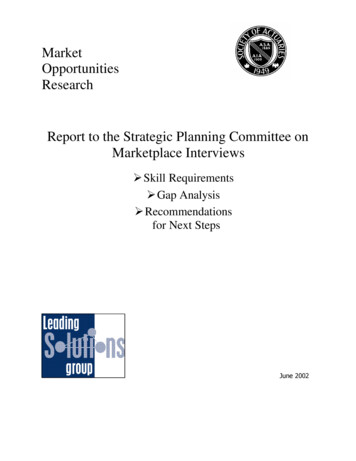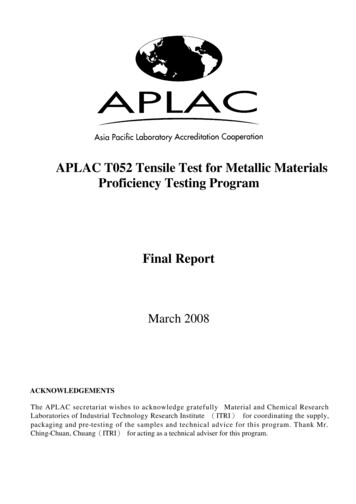
Transcription
APLAC T052 Tensile Test for Metallic MaterialsProficiency Testing ProgramFinal ReportMarch 2008ACKNOWLEDGEMENTSThe APLAC secretariat wishes to acknowledge gratefully Material and Chemical ResearchLaboratories of Industrial Technology Research Institute (ITRI) for coordinating the supply,packaging and pre-testing of the samples and technical advice for this program. Thank Mr.Ching-Chuan, Chuang(ITRI) for acting as a technical adviser for this program.
CONTENTSPage1. Introduction12. Program Feature13. Content of Appendices24. Statistical design of the program25. Outlier Results36. Technical Comments4APPENDIXESAppendix ASummary of ResultsInformation of Test617Appendix BPreparation of the samplesHomogeneity testing2323Appendix CInstructions to ParticipantsResult Sheet2729Appendix DStatistical ProceduresCalculations and Formulae3638
1. IntroductionThis report summarizes the results of APLAC T052 Tensile Test for Metallic Materials ProficiencyTesting Program involving testing laboratories for the Asia Pacific Laboratory AccreditationCooperation (APLAC), E u r o p e a n c o -operation for Accreditation (EA) and InterAmericanAccreditation Cooperation (IAAC). The mechanical properties requested in this program wereYield Strength, Tensile Strength and Percentage elongation after Fracture.Taiwan Accreditation Foundation (TAF) conducted this program. The aim of the program was toassess laboratories' ability to competently perform the tests examined.2. Program Feature(a) APLAC members, and EA and IAAC unaffiliated bodies were invited to participate. There werein total 60 laboratory participants nominated by 35 accreditation bodies (ABs) in this program.All samples were sent to the ABs and transferred to the participating laboratories. Elevenparticipating laboratories did not return results; hence the analysis of the results did not includethose laboratories.Table 1 Summary of Economies and oatiaCzech RepublicGermanyGreeceHK, goliaNo. of Participants12111111132131221EconomyNew poreSouth KoreaSri LankaSwitzerlandTaiwanThailandTurkeyUnited KingdomUSAViet NamTotalNo. of Participants233212321132116260(b) Participating laboratories were supplied two round bars of metallic materials. These arenumbered A and B for preparing standard 12.5mm round tensile test specimens.(c) Each participating laboratory is required to obtain the mechanical properties of Yield Strength,Tensile Strength and Percentage Elongation in sample A and sample B.(d) Prior to distribution the samples were analyzed for homogeneity. The testing results showed thatthe samples were sufficiently homogeneous. Therefore any results later identified as outlierscould not be attributed to any significant sample variability. (Appendix B)(e) Laboratories were requested to perform the tests according to their copy of the Instructions toParticipants and to record their results on the accompanying Results Sheet, both of which weredistributed to participants with the samples. (Appendix C)(f) Each laboratory was randomly allocated a unique code number for the program to enableconfidentiality of results. Its code number makes reference to each laboratory in this report.1
3. Content of AppendicesAPPENDIX A contains:(a) The results of two samples reported by laboratories and the calculated Z-Score result for eachtest on each sample.(b) A table of robust statistics for each test, such as number of results, median, normalized IQR,robust CV, minimum, maximum and range.(c) Z-Scores and ordered Z-Score charts calculated for laboratories for each test.(d) Test methods are reported for each laboratory.(e) Youden PlotsAPPENDIX B contains the details of sample preparation and homogeneity testing.APPENDIX C contains a copy of the Instructions to Participants and the Results Sheet, as suppliedto participants.APPENDIX D contains details of statistical procedures, calculations and formula.4. Statistical design of the programAn identical statistical design was used in this program. The samples labeled A and B had the samemechanical properties.Robust statistical procedures were used to generate the Z-scores and summary statistics for thesample - number of results, median, normalized interquartile range, minimum, maximum and range.For each laboratory, single robust Z-scores of between-lab and within-lab were calculated forsample A and sample B.2
5. Outlier ResultsThe outliers of feedback results are shown as below, the detail information please refers to the Summaryof Results in Appendix A.Lab CodeLab CodeYield StrengthBetween Laboratories Z score Within Laboratories Z score--6, 37Tensile Strength29, 37, 42, 5616, 643
6. Technical CommentsGeneral Comments1. More than 15 laboratories used the same testing speed before and after yield, they did not satisfy therequirements of ASTM E8/E8M-04.2. In the final report, it is recommended to notify the participants to choose the right specimen shape inthe operation of testing software. The wrong cross section area will lead to outlier results in the yieldand tensile strength.3. The data analysis of the yield strength, tensile strength and percentage elongation from theparticipants shows the good sample homogeneity.4. The information of “Use of Extensometer: Yes No ” should be added prior “Class ofExtensometer” in the result sheet in the future PT program of metallic materials tensile test. It willhelp to definitely judge whether the yield strength (determined by the offset method orextension-under-load method) is included in the statistical calculation.5. If any part of the fracture takes place outside the gage marks, the percentage elongation shall not beincluded in the statistical calculation (such as Lab 64).6. When failures happen during the test, it is recommended to ask the program organizer for moresamples to re-test if the time schedule is enough.7. Owing to requiring the data rounded to the nearest 1% and the lower percentage elongation ( 10%),even some laboratories reported the data to the nearest 0.1% or 0.01%, there were more than 17laboratories out of the Youden Plot Circle (CL 95%). The results might be unfair for the laboratoriesnear the Circle, such as Labs. 3, 4, 10, 11, 42, and 62, so the statistical calculation result ofpercentage elongation should not be reported in Outlier Results. To avoid the above phenomenahappening, it is recommended to report the percentage elongation to the nearest 0.1% at least in thefuture PT program of metallic materials tensile test.Comments for Participants1. The specimen dimensions of Lab 66 are much smaller than the recommended ones; it may be due tothe insufficient testing machine capacity or not be aware of the recommended dimensions. For thedecrease of the variation in the testing results, it is recommended that the participants should havethe sufficient capacity to perform the test.2. The yield and tensile strength of Lab 37 are abnormally low in sample A and sample B, it is due tothe wrong cross section area calculation as a square specimen.3. The fracture of sample A, Lab 64 takes place outside the gage marks, it is recommended that thepercentage elongation (including sample B) shall not be included in the statistical calculation. It alsohave to describe the reason why not be included in the final report.4. Lab 18, Lab 29, Lab 50 and Lab 56 did not use the extensometer to determine the yield strength(0.2% offset), the yield strength of the above 4 laboratories should be not included in the statisticalcalculation, but the tensile strength and percent elongation still be calculated. The above 4laboratories still filled the yield strength data on the result sheet, it showed they had no any sense onthe determination of the yield strength (0.2% offset).4
Appendix ASummary of ResultsInformation of Test5
Table 2 Summary of Results- Yield StrengthItem 1Lab Code Result 63738394142434547Result BYield 7800.191-0.4347848120.9311.1566Expanded N/AN/AN/AN/AN/AN/AN/AN/AN/AN/AN/A
Item 1Lab Code Result ult BYield 5040.289No. of resultMedianNormalized IQRRobust CV panded N/AN/AN/AN/AN/AN/AN/AN/A
Table 3 Summary of Results- Tensile StrengthItem 2Tensile 232-1.787-0.469-0.541.232Lab CodeResult AResult d N/AN/AN/AN/AN/AN/AN/AN/AN/AN/AN/A
Item 2Lab Result AResult BTensile -0.881.114-0.4110.117-0.0598588700.9110.469No. of resultMedianNormalized IQRRobust CV 85217.7912.088917688229Expanded AN/AN/AN/AN/AN/AN/AN/AN/AN/AN/AN/AN/AN/AN/AN/AN/A
Table 4 Summary of Results- Percentage Elongation after FractureItem 3Percentage Elongation after FractureBetweenWithinExpanded ab CodeResult AResult AN/AN/A10
Item 3Lab CodeResult AResult B4711.69Percentage Elongation after ded A0N/AN/AN/AN/AN/AN/A727313132.62875No. of result4848MedianNormalized IQR101.483101.483Robust CV (%)14.82614.82613714866MaximumMinimumRange11
Figure 1 Histogram of Yield StrengthItem1- Yield StrengthBetween Laboratory Z-Score66341 2817 64 59 5830 66 49 14 43569 34 71 1622 47 55732036 6732 38 704-3119 54 15 60 6225 10 21 52 2333911-6Laboratory Code Number37Item1 - Yield StrengthWithin Laboratory Z-Score637159 70 73 6423 60 39 17019-33165530 41 43 5425 69 5262 14 66511 38 4942-6Laboratory Code Number121516736 21637 1028 47 32 3458 22
Figure 2 Histogram of Tensile StrengthItem2 -Tensile StrengthBetween Laboratory Z-Score62531173 55 1652 29 38 581410 60 41 62 47 22 30 435969 6429 56 4228013 23 70 1817 3219 39 5-3415 36 49 676 21 34 54 715066-6Laboratory Code Number37Item2 - Tensile Strength6Within Laboratory Z-Score64336 4173 11 2122 115 52 32 38 70 39 59025 414 60 256 30 49 7169 23 2928 54 43 5 5066 39 1942 55-316-6Laboratory Code Number1334 58 376 17 62 1847 6710
Figure 3 Histogram of Percentage Elongation after FractureItem3 - Elongation after FractureBetween Laboratory Z-Score62 73329 32 36 604 42 49 5214 15 5910 37 43 47 62 6915 16 21 23 28 38 39 41 50 54 58 67 7006 11 30 349 17 19 25 713 1822 55 56-366-6Laboratory Code Number2 21 6Item3 - Elongation after FractureWithin Laboratory Z-Score64 10 11 34 37 43 52 66 693159 14 15 16 17 19 22 23 25 28 29 32 36 38 39 41 50 54 55 56 58 59 730-33 18 30
APLAC T052 Tensile Test for Metallic Materials Proficiency Testing Program Final Report March 2008 ACKNOWLEDGEMENTS The APLAC secretariat wishes to acknowledge gratefully Material and Chemical Research Laboratories of Industrial Technology Research Institute (ITRI) for coordinating the supply, packaging and pre-testing of the samples and technical advice for this program. Thank Mr.
